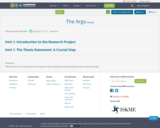
This resource is to introduce the writing of a thesis statement and introduction for a research essay.
- Subject:
- Arts and Humanities
- Material Type:
- Assessment
- Full Course
- Homework/Assignment
- Lecture
- Lesson Plan
- Reading
- Date Added:
- 11/08/2014

This resource is to introduce the writing of a thesis statement and introduction for a research essay.

This Communication and Argumentation seminar is an intensive writing workshop that focuses on argumentation and communication. Students learn to write and present their ideas in cogent, persuasive arguments and other analytical frameworks. Reading and writing assignments and other exercises stress the connections between clear thinking, critical reading, and effective writing.

This resource is designed to walk students through the process of completing a research project in any field of study. It covers the earliest stages of brainstorming and discussing, continues through researching and compiling sources; writing, documenting, revising, and polishing a paper; and finally presenting the research topic to a wider audience in a professional manner. The focus is on MLA format, though the course could be modified for other formats.
The first unit is an introduction to the project. It asks students to draw on knowledge of issues affecting their own community and world to help generate discussion that could eventually lead to a research topic.
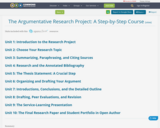
This resource is designed to walk students through the process of completing a research project in any field of study. It covers the earliest stages of brainstorming and discussing, continues through researching and compiling sources; writing, documenting, revising, and polishing a paper; and finally presenting the research topic to a wider audience in a professional manner. The focus is on MLA format, though the course could be modified for other formats.
The first unit is an introduction to the project. It asks students to draw on knowledge of issues affecting their own community and world to help generate discussion that could eventually lead to a research topic.
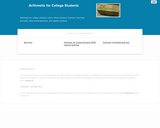
This course is an arithmetic course intended for college students, covering whole numbers, fractions, decimals, percents, ratios and proportions, geometry, measurement, statistics, and integers using an integrated geometry and statistics approach. The course uses the late integers modelintegers are only introduced at the end of the course.
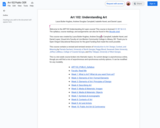
This is a ten-week course broken into thematic topics. Its current design is asynchronous online, though you will find a mix of asynchronous and synchronous activity options. It can be modified for any modality. Included are weekly activities, exercises, projects, and slides following the provided syllabus.
• ART102 Syllabus
• Week 1: What is Art? What do you want from art?
• Week 2: Elements of Art: Formal Elements
• Week 3: Elements of Art: Principles of Design
• Week 4: Describing Art
• Week 5: Media & Materials: Images
• Week 6: Media & Materials: Objects
• Week 7: Symbols & Iconography
• Week 8: Contexts of Art
• Week 9: Art and Artists
• Week 10: Public Art/Art & Controversy

Art 200 is an introductory course that chronicles the major developments in art that span from the Upper Paleolithic Period through the Fourteenth Century. This broad, comprehensive survey details this time period’s diverse range of artistic output while identifying the wider contexts (historical, social, cultural, religious) that affected the characteristics and motivations of early art production.
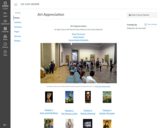
(Google Drive) Text of the book in “chapters” arranged by module—as well as assignments
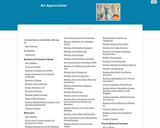
This course is particularly focused on helping you develop visual literacy skills, but all the college courses you take are to some degree about information literacy. Visual literacy is really just a specialized type of information literacy. The skills you acquire in this course will help you become an effective researcher in other fields, as well.
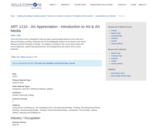
This entry-level course is designed to help you gain a general appreciation for art as well as to help you develop a working vocabulary for the knowledgeable analysis of art based on the Visual Elements and the Principles of Design. The syllabus is included in the course and contains the course objectives, student learning outcomes, list of assignments and names of the course textbooks.
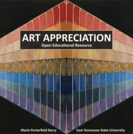
The Art Appreciation course explores the world’s visual arts, focusing on the development of visual awareness, assessment, and appreciation by examining a variety of styles from various periods and cultures while emphasizing the development of a common visual language. The materials are meant to foster a broader understanding of the role of visual art in human culture and experience from the prehistoric through the contemporary.
This is an Open Educational Resource (OER), an openly licensed educational material designed to replace a traditional textbook. The course materials consist of 24 lessons each with a presentation, reading list, and/or sample assignment. For ease of adapting, materials are available as PDFs and Microsoft PowerPoint or Word documents.

This course examines how people learn, practice, and evaluate traditional and contemporary craft techniques. Social science theories of design, embodiment, apprenticeship learning, skill, labor, expertise, and tacit knowledge are used to explore distinctions and connections among art, craft, and science. We will also discuss the commoditization of craft into market goods, collectible art, and tourism industries. Ethnographic and historical case studies include textiles, glassblowing, quilting, cheese making, industrial design, home cooking, factory and laboratory work, CAD-CAM. In-class demonstrations and hands-on craft projects will be included.

“This courseware includes resources copyrighted and openly licensed by multiple individuals and organizations. Click the words ‘Licenses and Attributions’ at the bottom of each page for copyright and licensing information specific to the material on that page.” Reviewer’s note: arguably the weakest of the full-text resources presented here, but may give a starting point for some resources

Art museums are powerful and contested institutions. They are also innovative sites of architectural and artistic practice. From the exhibitionary complex of the nineteenth century to the experiential complex of today, this course investigates the art museum from historical and contemporary perspectives, striking a balance between theoretical investigation and case studies of recent exhibitions and museum buildings. Where and why did the concept of the public art museum emerge, and how have its functions changed over time? How do art museums continue to shape our definitions of what art is? How have they responded to recent critiques of the self-described ‘universal’ museum and to claims for the ethical display of ill-gotten artifacts or the restitution of such objects as Greek vases and bronzes looted from Benin? And why is the Euro-American art museum so compelling a model that it has spread around the globe?
To address these and other questions, we will also go behind the scenes. Visits to local museums and discussions with curators are an essential component of the course.

This subject focuses on the objects, history, context, and critical discussion surrounding art since World War II. Because of the burgeoning increase in art production, the course is necessarily selective. We will trace major developments and movements in art up to the present, primarily from the US; but we will also be looking at art from Europe, Asia, Africa, Latin America, and the Middle East, as well as art “on the margins” — art that has been overlooked by the mainstream critical press, but may have a broad cultural base in its own community. We will ask what function art serves in its various cultures of origin, and why art has been such a lightning rod for political issues around the world.

This seminar looks at current theories on happiness and positive psychology as well as practical implications of those theories for our own lives. It explores the concept of happiness, different cultural definitions of happiness, and the connection between happiness, optimism, and meaning. Also explored are practical strategies for creating more opportunities for happiness in our lives and for learning how to deal more effectively with sources of unhappiness.
This seminar is part of the Experimental Study Group at MIT.

This course provides an introduction to bargaining and negotiation in public, business, and legal settings. It combines a “hands-on” skill-building orientation with a look at pertinent social theory. Strategy, communications, ethics, and institutional influences are examined as they influence the ability of actors to analyze problems, negotiate agreements, and resolve disputes in social, organizational, and political circumstances characterized by interdependent interests.

The course examines the earliest emergence of stories about King Arthur and the Knights of the Round Table in the context of the first wave of British Imperialism and the expanded powers of the Catholic Church during the twelfth and thirteenth centuries. The morphology of Arthurian romance will be set off against original historical documents and chronicle sources for the English conquests in Brittany, Wales, Scotland, and Ireland to understand the ways in which these new attitudes towards Empire were being mythologized. Authors will include Bede, Geoffrey of Monmouth, Chrétien de Troyes, Marie de France, Gerald of Wales, together with some lesser known works like the Perilous Graveyard, the Knight with the Sword, and Perlesvaus, or the High History of the Holy Graal. Special attention will be paid to how the narrative material of the story gets transformed according to the particular religious and political agendas of each new author.

This course introduces representations, techniques, and architectures used to build applied systems and to account for intelligence from a computational point of view. This course also explores applications of rule chaining, heuristic search, logic, constraint propagation, constrained search, and other problem-solving paradigms. In addition, it covers applications of decision trees, neural nets, SVMs and other learning paradigms.

This course introduces students to the basic knowledge representation, problem solving, and learning methods of artificial intelligence. Upon completion of 6.034, students should be able to develop intelligent systems by assembling solutions to concrete computational problems; understand the role of knowledge representation, problem solving, and learning in intelligent-system engineering; and appreciate the role of problem solving, vision, and language in understanding human intelligence from a computational perspective.